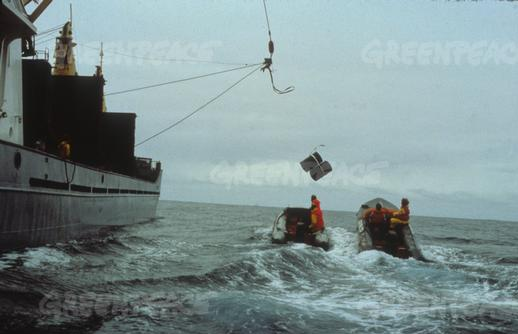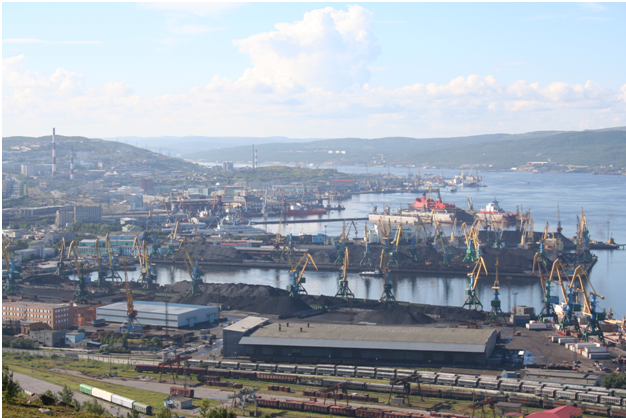
Blog
-
Geiger Readings for February 18, 2013
Ambient office =101 nanosieverts per hourAmbient outside = 82 nanosieverts per hourSoil exposed to rain water = 100 nanosieverts per hourAsparagus from Top Foods = 100 nanosieverts per hourTap water = 97 nanosieverts per hourFiltered water = 93 nanosieverts per hour -
Radioactive Waste 60 – Illegal Nuclear Waste Dumping in Russia 3
Yesterday, I blogged about illegal dumping of nuclear waste in the Arctic Sea by the Soviet Union and Russia. The Soviet Union and Russia also dumped nuclear waste in the Sea of Japan.
In 1993, after the fall of the Soviet Union, Greenpeace announced that they had received reports that a Russia freighter was on its way to the Sea of Japan to dump nine hundred tons of nuclear waste. Greenpeace filmed the dumping operation and Japanese television broadcast it repeatedly. Japan lodged a complaint with the Russian government with respect to the dumping which was thought to be illegal under international law. It was confirmed later that such Russian dumping had been going on since at least 1959.
The London Convention of 1972 outlawed dumping of nuclear waste in the world’s oceans. The Russians claimed that under the treaty they were allowed to dump “low-level nuclear waste.” The Russian government said that it had given the Russia Navy permission to dump seventeen hundred tons of radioactive waste into the Sea of Japan in October and November of 1993. Other nations disagreed with the Russia interpretation of the treaty.
The Japanese government had agreed to a one billion and eight hundred million dollar aid package for Russia earlier in 1993. One hundred million of that aid package was intended to help Russia dismantle nuclear weapons. The Russian President arrived in Japan about a week before Greenpeace publicized the Russian nuclear waste dumping to sign an agreement with regard to nuclear waste dumping in the Sea of Japan. The agreement called for joint monitoring of the level of radioactivity in the Sea of Japan.
The Japanese public, government agencies, and various Japanese organizations including unions of fishermen demanded an immediate halt to the Russian dumping of nuclear waste into the Sea of Japan. Critical letters flooded the Russian Consulates in Japan and telegrams were sent directly to the Russian President. In late October of 1993, Russia announced that it would suspend the dumping of nuclear wastes into the Sea of Japan. However, Russia said that it might be forced to resume such dumping if it was unable to build a new waste processing plant within the next eighteen months.
Japan had opposed the prohibition of low level radioactive waste dumping in the world’s oceans during the 1980s. Apparently they thought that they might want to dispose of their own waste in that way. After the Russia dumping was publicized in late 1993, signatories of the original London Convention met to discuss policy toward nuclear waste dumping. The outcome was an explicit and detailed ban on the dumping of any nuclear wastes into the ocean.
Nuclear waste continues to be dumped into the world’s oceans by unscrupulous nuclear companies and organized crime syndicates such as the Mafia. In disregard of the London Convention, even government agencies in nuclear nations have continued to dump nuclear wastes into the ocean and seas of the planet or they have looked the other way while other organizations did the dumping. The world has been very concerned about the radioactive materials leaking from Fukushima into the Pacific Ocean. Unfortunately, Fukushima is not the first incident of radioactive materials being discharged into the world’s oceans. Illegal ocean nuclear waste dumping has been going on for decades and it continues today, totally apart from Fukushima.
Greenpeace and Russian nuclear waste ship:
-
Radiation News Roundup February 17, 2013
How to date Japanese women who haven’t been exposed to radiation. globalpost.com
‘Deformed’ containment vessel cover at Fukushima Unit 3 reactor. enenews.com
Scientists at Cambridge University received £2 million in funding from Britain’s nuclear weapons research organization in the space of just two-and-a-half years. cambridge-news.co.uk
-
Geiger Readings for February 17, 2013
Ambient office = 81 nanosieverts per hourAmbient outside = 85 nanosieverts per hourSoil exposed to rain water = 77 nanosieverts per hourAsparagus from Top Foods = 87 nanosieverts per hourTap water = 88 nanosieverts per hourFiltered water = 62 nanosieverts per hour -
Radiation News Roundup February 16, 2013
New report shows 50 tons of rubble fell in Unit 3 pool, spent fuel is highly damaged. enenews.com
Goldman Sachs is getting out of the failing uranium industry. nuclear-news.net
Over the last few months, Governor-Elect Terry McAuliffe has come out in strong opposition to lifting Virginia’s current moratorium on uranium mining. nuclear-news.net
-
Geiger Readings for February 16, 2013
Ambient office = 138 nanosieverts per hourAmbient outside = 128 nanosieverts per hourSoil exposed to rain water = 114 nanosieverts per hourAsparagus from Top Foods = 54 nanosieverts per hourTap water = 98 nanosieverts per hourFiltered water = 67 nanosieverts per hour -
Radiation News Roundup February 15, 2013
TEPCO doesn’t mention the possibility of land subsidence under contaminated water tanks at Fukushima. Fukushima-deiary.com
Cracks up to 40 feet in concrete found near tanks of radioactive waste at Fukushima. Enenews.com
MOD names possible nuclear sites for interim storage of submarine waste. Yournuclearnews.com
-
Geiger Readings for February 15, 2013
Ambient office = 90 nanosieverts per hourAmbient outside = 123 nanosieverts per hourSoil exposed to rain water = 119 nanosieverts per hourYellow bell pepper from Top Foods = 720 nanosieverts per hourTap water = 105 nanosieverts per hourFiltered water = 77 nanosieverts per hourAlaskan Copper River Salmon = 88 nanosieverts per hour -
Radioactive Waste 59 – Illegal Nulcear Waste Dumping in Russia 2
Today, I am going to continue blogging about illegal dumping of wastes in Russia. There is a Russian Naval base at Murmansk on the Arctic Sea. Dumping nuclear waste into the world’s oceans has been banned by international treaty for over thirty years. It has been know for decades that the Soviet Union and Russia have been illegally dumping nuclear materials into the Arctic Sea. Because of Cold War secrecy, the exact quantities and types of nuclear materials are not completely known.
Yesterday, I blogged about the Soviet and Russian practice of dumping the effluent from the nuclear weapons factory near Chelyabinsk into the River Techa. The Techa empties into the Arctic Sea and much of the radioactive contamination from Chelyabinsk wound up in there.
The Naval base at Murmansk services nuclear powered surface vessels and submarines. Between 1964 and 1986, over seven thousand tons of solid radioactive waste and fifty six thousand cubic feet of liquid waste was dumped into the Arctic Sea. In addition, at least eighteen nuclear reactors from Soviet and Russian nuclear submarines and nuclear icebreakers were sunk in the Arctic Sea off of Murmansk. A nuclear sub was intentionally sunk off Murmansk after an accident in 1968. In addition, another Soviet nuclear sub sank three hundred miles off of Norway. That sub contained two nuclear reactors and two nuclear warheads. In 1993, the Russians admitted that a Russian ship discharged nine hundred tons of radioactive water from decommissioned nuclear subs.
A curie is a measure of radioactivity from decaying radioactive isotopes. A single curie could be sufficient to kill someone with prolonged exposure. It is estimated that between 1953 and 1991, the Soviet Union dumped over three hundred thousands of curies into the Arctic Sea. Experts maintain that radioactive materials that are dumped at sea need to be at least three thousand feet below the surface in order for it not to be a threat. Much of the dumped Soviet and Russian waste is in shallower water and a danger to the food chain.
Norway in particular is very concerned about the potential damage to prime fishing grounds in the Arctic Sea. IN 1993, Arctic Sea seals began dying of blood cancer. Since seals are near the top of the food chain, this suggests that a lot of fish are contaminated. There may be a threat to human beings eating fish from that area. Norway and other Scandinavian countries depend of fish from the Arctic Sea to feed their own people and for export sales.
Russia has responded to international outrage over their dumping practices in the Arctic Sea by claiming that they are running out of places on land to dump nuclear waste and they will have to keep dumping nuclear waste into the Arctic Sea unless the international community provides funding for other waste disposal alternatives. I guess this could be referred to as “nuclear blackmail.”
Murmansk on the Arctic Sea:





